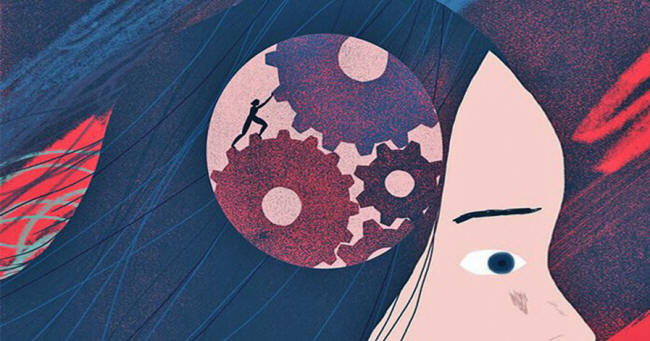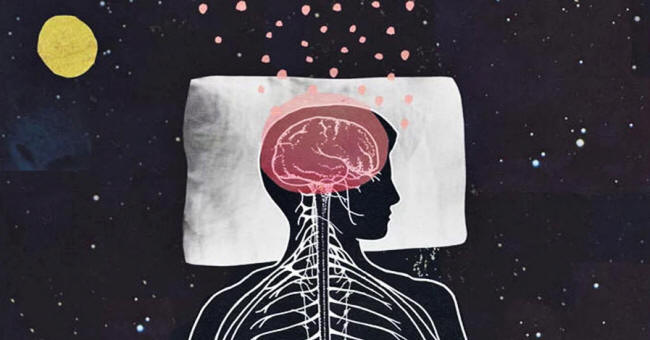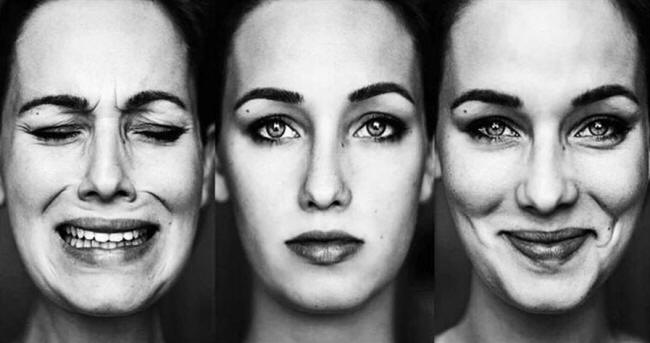|
by Thich Nhat Hanh
September 14, 2017
The Inner Workings of
Our Minds
The Vietnamese Zen Master, Thuong Chieu, said:
To understand our minds, we need to understand our consciousness. The Buddha taught that consciousness is always continuing, like a stream of water.
Consciousness has four layers.
The four layers of consciousness are,
Layer One - Mind
Consciousness
It uses up most of our energy. Mind consciousness is our 'working' consciousness that makes judgments and plans; it is the part of our consciousness that worries and analyses.
When we speak of mind consciousness, we're also speaking of body consciousness, because mind consciousness isn't possible without the brain. Body and mind are simply two aspects of the same thing.
Mind consciousness is the part of our consciousness
that
worries and analyses.
We shouldn't say that consciousness is born from the brain, because the opposite is true:
The brain is only 2 percent of the body's weight, but it consumes 20 percent of the body's energy.
So using mind
consciousness is very expensive. Thinking, worrying, and planning
take a lot of energy.
Layer Two - Sense
Consciousness
We sometimes call these senses 'gates,' or 'doors,' because all objects of perception enter consciousness through our sensory contact with them.
Sense consciousness always involves three elements:
There are many names for this kind of consciousness. Mahayana tradition calls this store consciousness, or alaya, in Sanskrit. The Theravada tradition uses the Pali word bhavanga to describe this consciousness.
Bhavanga means constantly flowing, like a river.
Store consciousness is also sometimes called root consciousness (mulavijñana in Sanskrit) or sarvabijaka, which means,
In Vietnamese, we call store consciousness tang.
Tang means to keep
and preserve.
Sense consciousness involves the sense organ, the sense object,
and our experience of it.
Store consciousness is like a museum.
A museum can only be called a museum when there are things in it. When there is nothing in it, you can call it a building, but not a museum. The conservator is the one who is responsible for the museum.
Her/his function is to keep the various objects preserved and not allow them to be stolen.
But there must be things to be stored, things to be kept. Store consciousness refers to the storing and also to what is stored - that is, all the information from the past, from our ancestors, and all the information received from the other consciousnesses.
In Buddhist tradition,
this information is stored as bija, seeds.
That information, a new seed, falls into the store continuum. Store consciousness has the capacity to receive the seed and store it in its heart. Store consciousness preserves all the information it receives.
But the function of store
consciousness isn't just to receive and store these seeds; its job
is also to process this information.
Store consciousness can process this information without a lot of work on your part.
So if you want to save your energy,
Allow your store
consciousness to do most of the processing.
Store consciousness - like a museum - stores and preserves things
from your past.
Store consciousness may give the order to your arm to pull up the blanket without your even being aware of it. Store consciousness operates in the absence of mind consciousness.
It can do a lot of
things. It can do a lot of planning; it can make a lot of decisions
without your knowing about it.
If the vendor asks us what we like, we can point to or verbalize the object of our desire. And we likely have the impression that we are free people at this moment, using our mind consciousness to select things that we like.
But that is an illusion. Everything has been decided already in store consciousness.
At that moment we are
caught; we are not free people. Our sense of beauty, our sense of
liking or disliking, has been decided very certainly and very
discreetly on the level of store consciousness.
Store consciousness dictates many of the things we do, because store consciousness continuously receives, embraces, maintains, processes, and makes many decisions without the participation of mind consciousness.
But if we know the practice, we can influence our store consciousness; we can help influence how our store consciousness stores and processes information so as to make better decisions.
We can influence it.
We are never fully free– our store consciousness
has already been decided for us.
When you are around a group of people, although you want to be yourself, you are consuming their ways, and you are consuming their store consciousness.
Our consciousness is fed with other consciousnesses. The way we make decisions, our likes and dislikes, depend on the collective way of seeing things.
You may not see something
as beautiful, but if many people think that it's beautiful, then
slowly you may come to accept it as beautiful also, because the
individual consciousness is made up of collective consciousness.
That's why selecting the people you are around with is very important.
It's very important to
surround yourself with people who have loving-kindness,
understanding, and compassion, because day and night we are
influenced by the collective consciousness.
Store consciousness is like a garden where we can plant the seeds of flowers, fruits, and vegetables, and then flowers, fruits, and vegetables will grow. Mind consciousness is only a gardener.
A gardener can help the land and take care of the land, but the gardener has to believe in the land; believe that it can offer us fruits, flowers, and vegetables.
As practitioners, we can't rely on our mind consciousness alone:
Decisions are being made
down there.
We consume others' store consciousness,
therefore we must choose our friends wisely.
That hard drive is like store consciousness. Although the information doesn't appear on the screen, it is still there. You only need to click and it will manifest.
The bija, the seeds in store consciousness, are like the data you store on your computer. If you want to, you can click and help it appear on the screen of mind consciousness. Mind consciousness is like a screen and store consciousness is like the hard drive, because it can store a lot in it.
Store consciousness has
the capacity of storing, maintaining, and preserving information so
that it can't be erased.
The nature of the information that's being kept and processed by the store consciousness is always flowing and always changing.
Love can be transformed into hate, and hate can be transformed back into love.
In store consciousness there are elements of ignorance - delusion, anger, fear - and these elements form a force of energy that clings, that wants to possess.
This is the fourth level of consciousness, called manas, which I like to translate as 'cogitation.' Manas consciousness has, at its root, the belief in a separate self; the belief in a person.
This consciousness, the feeling and instinct called 'I am,' is very deeply seated in store consciousness. It's not a view taken up by mind consciousness.
Deeply seated in the
depths of store consciousness is this idea that there is a self that
is separate from non-self elements. The function of manas is
to cling to store consciousness as a separate self.
Imagine that a vine puts forth a shoot, and then the shoot turns back and embraces and encircles the trunk of the tree.
This deep-seated delusion - the belief that there is a self - is there in store consciousness as the result of ignorance and fear, and it gives rise to an energy that turns around and embraces store consciousness and makes it the only object of its love.
The function of manas is to appropriate store consciousness
as its own.
The Illusion of
Freedom
It's always embracing, always holding or sticking to store consciousness. It believes store consciousness to be the object of its love. That's why store consciousness isn't free. There's an illusion that store consciousness is 'me,' is my beloved, so I can't let it go.
Day and night there's a secret, deep cogitation that this is me; this is mine, and I have to do everything I can to grasp, to protect, to make it mine. Manas is born and rooted in store consciousness.
It arises from store consciousness and it turns around and embraces store consciousness as its object:
The function of manas is to appropriate store consciousness as its own.
Store consciousness is a process - always flowing, always present, never interrupted. But mind consciousness may be interrupted. For example,
Some neuroscientists use the term 'background consciousness' to describe store consciousness. And the level of mind consciousness is what they call, simply, consciousness.
Whether you're awake or
you're asleep, whether you're dreaming or not dreaming, the work of
processing and storing information is continuously done by store
consciousness, whether you want it to or not.
Awake or asleep - the work of processing and storing information
is continuously done.
It's funny, but it happens very, very often. When you drive your car, you are able to avoid many accidents, even if your mind consciousness is thinking of other things. You may not even be thinking of driving at all.
And yet, most of the time at least, you don't get into an accident.
This is because the impressions and images provided by eye consciousness are received by store consciousness, and decisions are made without ever going through mind consciousness.
When someone suddenly holds something close to your eyes - for instance, if someone is about to hit you, or when something is about to fall on you - you react quickly.
That quick reaction,
that decision, is not made by mind consciousness.
Whether we're driving, manipulating a machine, or performing other tasks, many of us allow our sense consciousness to collaborate with store consciousness, which enables us to do many things without the intervention of mind consciousness.
When we bring our mind
consciousness into this work, then suddenly we may become aware of
the mental formations that are arising.
Understanding the
Mental Formations
When we look at a flower, we can recognize many of the elements that have come together to make the flower manifest in that form. We know that without the rain there can be no water and the flower cannot manifest. And we see that the sunshine is also there.
The earth, the compost, the gardener, time, space, and many elements came together to help this flower manifest.
The flower doesn't have a
separate existence; it's a formation. The sun, the moon, the
mountain, and the river are all formations. Using the word
'formation' reminds us that there is no separate core of existence
in them. There is only a coming together of many, many conditions
for something to manifest.
Impermanence is
one of the marks of reality, because everything changes.
Seeing things as formations remind us that everything changes;
everything is impermanent.
When there's contact between a sense organ (eyes, ears, mouth, nose, body) and an object, sense consciousness arises. And at the moment your eyes first gaze on an object, or you first feel the wind on your skin, the first mental formation of contact manifests.
Contact causes a
vibration on the level of store consciousness.
It's like when a flying insect lands on the surface of the water and causes the water to ripple a little bit. After the insect flies off, the surface of the water becomes completely calm again.
So although the mental
formation manifests, although the current of the life continuum
vibrates, there's no awareness born in mind consciousness because
the impression is too weak.
Of the fifty-one mental formations, contact is the first, followed by attention, feeling, perception, and volition. These five mental formations can take place very quickly, and their intensity, their depth, varies in each level of consciousness.
When we speak of
attention, for instance, we can see attention in the context of
store consciousness, and we can see attention on the level of mind
consciousness, and the intensity or the depth of attention is quite
different on the two levels.
For example, anger is a mental formation.
But in fact, mind consciousness is not just anger, because later on compassion arises, and at that time, mind consciousness becomes compassion.
Mind consciousness is, at
various times, all fifty-one mental formations, be they positive,
negative, or neutral.
Mind consciousness is, at various times,
all fifty-one mental formations.
It's as if we're
discussing a formation of birds. The formation holds the birds
together, and they fly beautifully in the sky. You don't need
someone to hold the birds and keep them flying in one formation. You
don't need a self to create the formation.
You don't need someone up above to perform the raining. It's not that there is the rain, and there is the one who causes the rain to fall. In fact, when you say the rain is falling, it's very funny, because if it weren't falling, it wouldn't be rain. In our way of speaking, we're used to having a subject and a verb.
That's why we need the word 'it' when we say, "it rains."
'It' is the subject, the one who makes the rain possible. But, looking deeply, we don't need a 'rainer,' we just need the rain. Raining and the rain are the same. The formation of birds and the birds are the same - there's no 'self,' no boss involved.
When we meditate, we practice looking deeply in order to bring light and clarity into our way of seeing things.
The moment the vision of
no-self is there, manas, the elusive notion of 'I am,'
disintegrates, and we find ourselves enjoying, in this very moment,
freedom and happiness...
|











